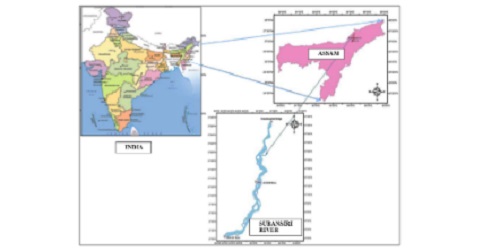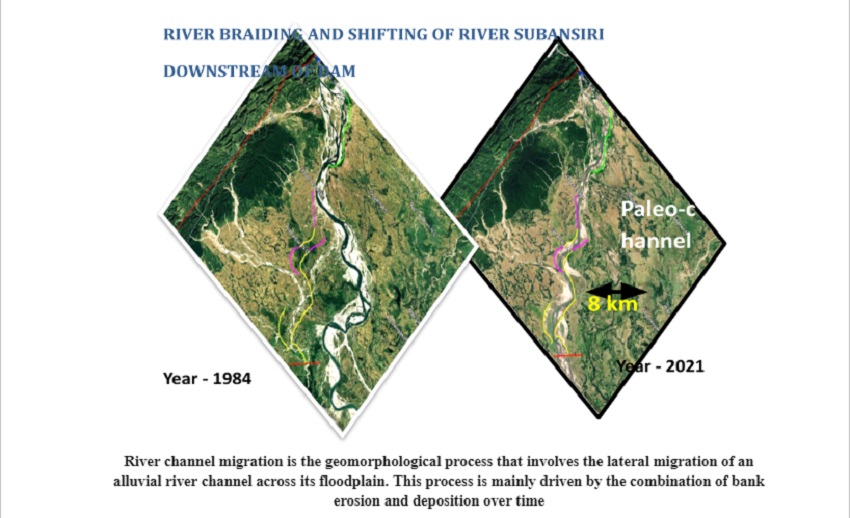Subansiri Lower H E Project: Downstream River Bank Protection Solution– PART-1: River Morphology
River Subansiri, the largest tributary of River Brahmaputra, has a total length of 375 km, draining over a basin of 37,000 sq. km. The river remains stable while flowing through the mountainous portion of the basin, but it becomes unstable when it enters the alluvial plains of Assam. The reason for the river becoming unstable may be attributed to a dramatic reduction in the slope as it enters the plain portion of the basin, which is mostly confined to the state of Assam.
A sudden change in slope could result in the dissipation of enormous energy, leading to the unloading of a significant amount of sediments in the downstream valley. The heavy siltation of the river results in the braiding of the river, leading to erosion of banks during the monsoon period as river banks are composed of alluvial silt.

In addition to this, the construction of the 2000 MW Subansiri Lower H.E. Project on the Arunachal Pradesh–Assam border at Gerukamukh in Dhemaji District had raised concern about adverse impact on flora and fauna in the downstream portion, with serious concern about the need to address the endemic problem of erosion of alluvial regime of river Subansiri. With the objective to protect the downstream of the Subansiri H.E. project, measures mentioned below are being suggested,
- Provision of elevated embankments with proper protection measures from the dam site to about 15km downstream to control the river discharge
- NHPC decided to carry out river bank protection works up to 30 Km downstream of the Subansiri Lower H.E Project.
- Strengthening and raising the embankments of the Subansiri River
- Development of thick vegetation cover or green belt all along the river banks.
Data Used :
The basic data used in this study are digital satellite images comprising of images of the years 1984 to 2014 with good visibility and free of clouds. The bank line of the Brahmaputra River is demarcated from each set of imageries and the channel patterns are digitized using ArcGIS software. For the purpose of the Study, the entire river from the dam site at Gerukamukh to Dhunagurighat was divided into 60 sections. Satellite imagery of Subansiri River in 1984, 1994, 2004 & 2014 is shown below. As it is observed that river Subansiri has shifted about 8 km in the last 40-45 years @ 200 m per year towards its right side.

Design of bank protection structures:
River passing through populated/agricultural areas necessitates protection of adjacent lands and properties threatened by erosion. In order to limit the movement of the bank of a meandering river, certain structures are constructed on the riverbank, which are called riverbank protection works. The purpose of bank protection may be training of river, protection of adjacent land and properties, protection of nearby hydraulic structures like embankments etc.
Different measures have been adopted to reduce flood/erosion losses and protect the flood plains. Some of the structural measures for flood management/erosion control which bring relief to flood-prone areas by managing the flood and thereby the flood levels are:
- Construction of flood embankments
- Channel improvement
- Watershed management
- Construction of spurs, groynes etc.
- Construction of bank revetment along with launching apron
- RCC porcupines and
- Vetivers grass, geo-cells, geo-bags etc.
The structural measures for flood management mentioned above are designed as per Bureau of Indian Standards (BIS) codes.

River Bank Protection / Erosion Control Measures:
River banks when normally subjected to direct attack of the river causes bank failures, leading to one or more of the following consequences:
- Washing away of the soil particles from the bank by a strong current.
- Undermining the toe of the bank by eddies, current etc followed by a collapse of overhanging material deprived of support.
- Sliding or sloughing of the slope when saturated with water by floods of long duration. Saturation decreases the shear strength of the soil. The stability is further reduced by the pressure of seepage flow.
- Piping in sub-layers due to the movement of groundwater towards the river, which carries away material with it.
River bank, therefore, requires protective measures against the above-mentioned failures and the commonly employed protective measures could be broadly classified into:
- Revetment/mattress to protect against erosive action of the river.
- Spurs/groynes to deflect/dampen high velocity attacking the embankment
- Different grade control measures to tame a river flowing in steep terrain.
- Improving shear strength of embankment soil by growing shallow-rooted vegetation.
The above-mentioned bank protection works can be broadly classified as either direct or indirect interventions. The protective measures carried out directly on the river bank are normally classified as direct protection measures. Some of the widely adopted direct protection measures are the provision of vegetal cover, pavement, revetment, and grading of slopes. On the other hand, protective works not directly constructed on the banks, but constructed in front of the banks for reducing the erosive forces either by deflecting the current away from the banks or by inducing silt deposition near the bank are treated as indirect interventions.
Vegetal cover using shrubs and willows could be opted as a direct protective measure in case the current is not strong. On the other hand, the banks will need to be protected by pitching using stone/boulders, concrete blocks, and sand-filled geo-bags/geo-mattress in case of strong currents. The bank pitching is provided along with the launching apron to prevent the scouring under the water and the consequent fall of pitching. Besides these, RCC porcupines can also be laid over the bank slopes and also protrude into the river section to induce siltation near the bank.
Biswajit Basu is Director (Projects) at NHPC Ltd, Miren Kr Verma is General Manager at NHPC Ltd and A. N. Mohammed is Consultant at NHPC Ltd.

